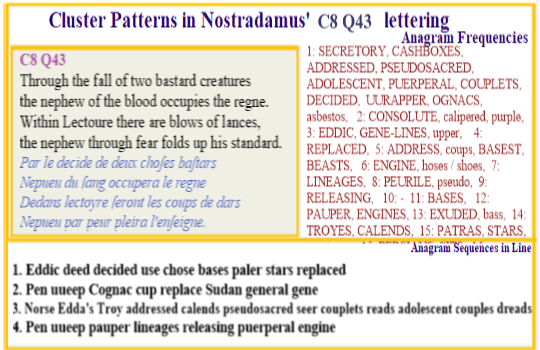 Analyses of all verses
Analyses of all verses
|
 Web Site
Web Site |
 All
Sefirots All
Sefirots |
Nostradamus C8 Q43: His use of Nordic poetry for the emotions of family gone awry.
Copyright: Allan Webber, December 2015
 The anagrams of this verse reveal Nostradamus' usage of the
Norse
Edda's
couplets (ſeron - t les
coup - s de da) .
The anagrams of this verse reveal Nostradamus' usage of the
Norse
Edda's
couplets (ſeron - t les
coup - s de da) .
These are used to complement the story of the text by adding that the two deaths mentionned involve a newly-born child puerperal ( ar peur ple) and an adolescent (edans lecto) from pauper (eu par p, par peu) lineages (a l'enſeig).
The verse's anagrams also imply this ancestry leads to a taking of the throne. These children are from the Celt lands near Cognac, France where the interface with Roman culture produced a people whose values still represent their ancestry.
Extra Info:
Although much of the anagram-based story is taken up with the relationship between Nostradamus' couplets and the method by which the Norse Edda's include their pagan lunar calendar it also embraces the Roman Calends.
The term Decans identifies the first day of each month in the Roman calendar and signify the start of a new lunar cycle.
The pre-Christian Norse also used a lunar calendar, the details of which are believed to be embodied in Snorri Sturluson's Prose Edda. These were written after Christianity reached Iceland.
This corruption of pagan-Christian values Nostradamus refers to as pseudo-sacred ( es coups de dars) in the anagrams. The Edda also demonstrates there was a Nordic belief that their ancestors came from Troy.
In the anagrams of tNostradamus' verse, where pseudo-sacred occurs, there is a sequence saying Norse couplets addressed Troy calends ( ſeron - t les coup -s de dars De - dans lec - toyr) which firmly locks in the mixing of two cultures ideas on lunar calendars.
Key Ideas:
pseudosacred, Eddic, cashboxes, couplets, addressed, calipered, puerperal, upper, gene-lines, died, consolute, cognacs, purple, asbestos, wrapper, decided, basest, engine, replaced, address, releasing, pauper, lineages, Troyes, calends, deduce, stars, Eddas, sadder, ensign, Celts, adolescent, leader, weep.